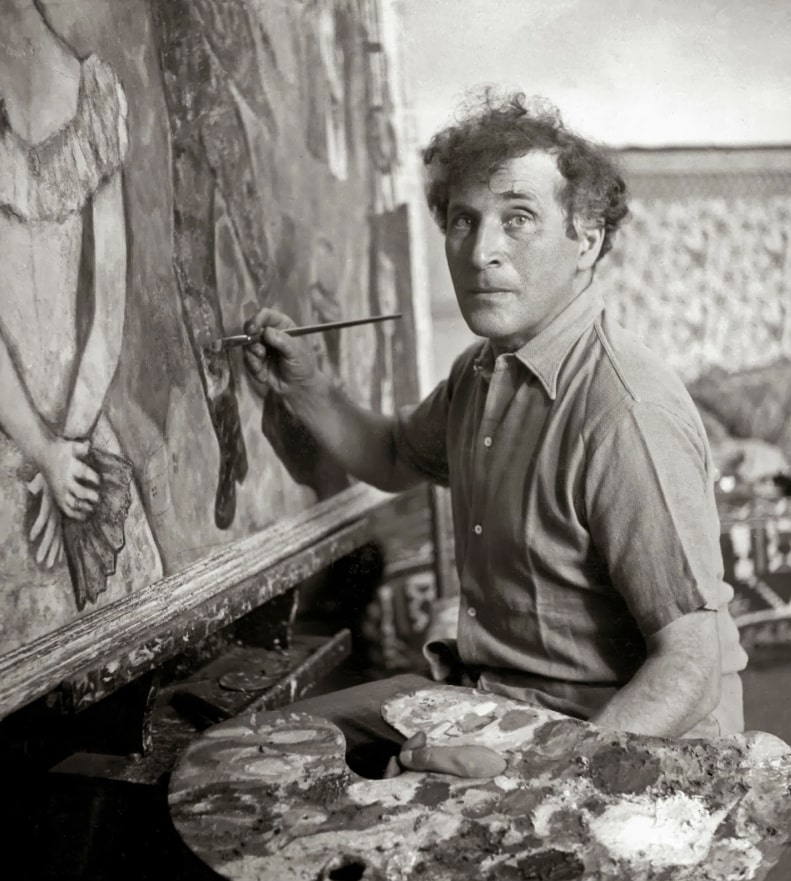The future famous Belarusian, French surrealist artist and graphic artist was born on July 6, 1887 in the town of Liozno, near Vitebsk, at that time within the Jewish settlement in the Russian Empire. He was named Moishe at birth. His father followed Hasidic traditions, so there were no visual images of G-d in the house. Studied at the Vitebsk four-grade school. In the same city, he met his future wife, Bella Rosenfeld, who came from a wealthy family. In 1906, Mark studied fine arts at the art school of the local painter Y. Pen, later moved to St. Petersburg, where he studied painting at the Drawing School of the Society for the Promotion of Arts (headed by M.K. Roerich). In this city, Mark wrote the first known works – “Funeral” and “Birth”. Thanks to an acquaintance with an admirer of his work (and in the future, his best friend), lawyer M. Vinaver, he received a small scholarship to study in Paris.
In the French capital, the talented artist met avant-garde artists and poets and began to write. In the works of that period, the influence of Picasso and Matisse can already be felt, but Chagall's own, unique manner also shines through.
In 1914, Chagall returned to his hometown, where he married Bella. Soon they had a daughter, Ida.
During the First World War, Chagall joined the Military Revolutionary Committee. After the Bolshevik coup, he was appointed the authorized commissar for the arts of the Vitebsk province. For some time, the artist lived and worked in Moscow (as a teacher at the Jewish labor school-colony of the III International for the homeless in Malakhovka; he created a number of costumes for the performances of the famous Jewish writer Sholom Aleichem and murals for the Chamber Theater). Later, he travels with his family to Lithuania, Germany (where he previously made a deep impression on the artists of German expressionism and began to make his first engravings), and, eventually, to France. In 1937, the artist received French citizenship.
During World War II, the management of the Museum of Modern Art in New York invited M. Chagall to move from Nazi-controlled France to the United States, where, in the end, he and his family ended up in 1941. A few years later, tragedy struck the family: Bella died. Later, the artist had an affair with V. McNeill-Haggard, the daughter of the former British consul in the USA, because of which a son, David, was born. However, already in 1947, Chagall returned to France, where he soon married for the second time – to V. Brodskaya (“Vavi”). Despite his stormy personal life, the only muse for him forever remained Bella (“There is only one color in our life, like on an artist's palette, which gives meaning to life and creativity. It is the color of love”).
In the 1970s, at the invitation of the Ministry of Culture, the internationally recognized artist came to the USSR. Tretyakov Gallery, where his exhibition was held, and the Museum of Fine Arts named after M. Chagall presented his works to A. S. Pushkin.
The master died on March 28, 1985, in Saint-Paul-de-Vence (Provence, France) and was buried in the local cemetery.
The outstanding artist left behind many works that combined elements of Cubism, Surrealism, Expressionism, Fauvism and Symbolism. M. Chagall worked in various branches of fine art: from drawings and paintings to stained glass, tapestries, illustrations, prints (more than 1,000 lithographs and 500 prints made by him for various publications are known) and ceramics. In 1931, while preparing to work on a series of etchings for the Bible, the artist made a two-week trip to Eretz Israel. “I wanted to see Palestine,” he would say later. “I wanted to touch the ground.” Staying true to his Jewish origins, the artist used episodes from the Torah (Old Testament) in his own works, from the creation of man to David's slaying of Goliath.
Chagall is considered one of the most popular innovators of the Paris School of the 20th century because of his invented images of flying lovers, melancholic clowns, fantastic animals, religious figures and biblical prophets. According to critics, he managed to reach the level of visual metaphor, which is rarely used in modern art (“Only with Chagall did metaphor triumphantly return to modern painting.” A. Breton, founder of surrealism).
Iryna Radchenko

